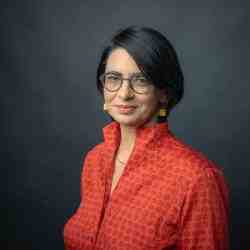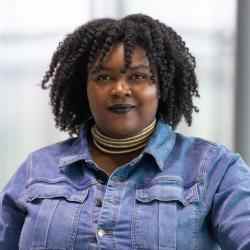Bevezetés
idris brewster is rewriting the rules of civic infrastructure by enabling communities—especially those historically excluded—to author, own, and mobilize their collective histories. Through Kinfolk Tech, he is transforming place-based memory into a new form of civic power.
Az új ötlet
idris brewster is tackling narrative erasure—the systemic, often invisible forces that disappear Black, Indigenous, and undertold histories from public consciousness and civic space. In response, he is building Kinfolk Tech, a community-driven platform that challenges who has the authority to record, remember, and retell history. Kinfolk Tech introduces new digital tools that empower people to engage with their stories on their own terms, reframing history as a living, participatory act.
In 2017, as debates over Confederate monuments ignited across the United States, idris and a group of friends in New York City offered a bold intervention. While many were locked in a debate over whether or not to remove a towering statue of Christopher Columbus, idris imagined a third way: using augmented reality, they projected a statue of Toussaint Louverture—an 18th-century Haitian revolutionary leader—onto the existing monument, visible through a free mobile app. This act of technological resistance sparked the beginning of a larger movement.
What started as a way to “install” neglected figures into public spaces has evolved into an ambitious civic architecture. Today, Kinfolk Tech offers a scalable digital infrastructure that allows communities to map their histories directly onto the places where they unfolded. The platform combines storytelling, community workshops, and education to build a “living digital archive”—one authored and curated by the very people it represents, not the institutions that have historically excluded them.
Kinfolk Tech is not just documenting history—it is decentralizing and democratizing it. For example, when you walk through Central Park today, you may see an urban respite of open green space. But through Kinfolk Tech, you can also learn the story of Seneca Village, a once-thriving free Black community that was demolished to make way for the park – all archives burned except for two pictures and a ledger. Kinfolk Tech turns the park into a layered, multifaceted space—a site of joy and erasure, memory and resistance.
While traditional history projects keep community narratives within museum walls or academic databases, Kinfolk Tech brings these stories to life in the spaces where history was lived—in basements, on sidewalks, in classrooms, and in neighborhoods. It transforms everyday environments into portals of collective memory and possibility. Smartphones become tools of civic engagement, revealing an invisible “third space” where suppressed stories come alive.
Through hyper-local workshops, Kinfolk Tech trains and mobilizes “memory workers”—community members who gather stories, animate public spaces with narrative, and embed historical truth into education, organizing, and daily life. These grassroots actions feed into a larger mission: challenging and remaking the national narrative.
The end goal is clear: to lay a foundation for belonging, justice, and collective imagination through a more inclusive, honest telling of who we are, who we’ve been, and what we’re living through. Kinfolk Tech is not only fighting erasure—it’s building the future memory system of a truly representative democracy.
A probléma
The dominant systems that preserve and teach history in the United States—government institutions, education systems, tech platforms, and cultural gatekeepers—have historically excluded Black, Indigenous, and marginalized communities.
Monuments and memorials instruct our shared understanding of history—who gets celebrated and who gets reduced. Today, our public realm disproportionately honors a limited few and overlooks the multitudes who have made and shaped our society: of the 48,000 monuments in the U.S., less than 0.5% reflect people of color. This failure to represent the multiplicity of this country impacts how Americans perceive, distribute, and demonstrate power: you can’t be what you can’t see.
The impact is not abstract—it's immediate and devastating. When communities do not see themselves reflected in history, it fractures their connection to place, identity, and power. It distorts how young people understand their own position in and experience of the world, and leaves communities vulnerable to invisibility, misrepresentation, and exclusion from public life. Why should young people care about national history if it doesn’t involve them? A lack of belonging decreases social trust (which is critical for a healthy democracy) and limits imagination and hope.
In its lack of complexity, this singular, drab history is also easily weaponized. Systems of power don't just forget; they actively work to erase, rewrite, and sanitize historical narratives. The negation required to sustain oppressive power structures and myths of deservedness create vacuums of understanding where "truth" is easy to manipulate. A flattened history is a lobotomized one— ignoring past atrocities and uncomfortable truths about our country’s foundation constitutes an active form of negation that shapes both our collective consciousness and political landscape.
We are also living through a radical shift in how the public sphere operates. As our lives are increasingly spent online, we've lost the self-correcting architecture of the "commons" and instead, our inputs have become increasingly extreme and self-affirming. Digital platforms have become the primary places where we communicate, share knowledge, and engage in public dialogue. These new dynamics shape how information circulates, whose stories get told, what narratives get amplified, and what counts as true or real or resonant. But many people don't fully grasp this shift and aren't equipped to navigate it.
The potential for digital platforms to be used for “the good of all” is proving quite difficult: dominant technologies are designed to mine data, monetize attention, and influence behavior, thus accelerating existing patterns of marginalization. The result is a distortion of reality and a decrease in attention-span that has contributed to epidemic rates of loneliness, mental unwellness, and a decline in the social capital that is essential for a healthy democracy.
The problem of narrative erasure is being addressed through important but fragmented efforts, such as community history projects, museum exhibitions, public art initiatives, and educational campaigns. Many nonprofits, libraries, and universities work to preserve community stories and diversify historical representation, but these efforts tend to be isolated from one another, under-resourced, and often dependent on the very institutions that have historically excluded BIPOC communities. Projects are often one-off, lack long-term sustainability, or exist behind institutional gates. Few are truly community-authored, scalable, or designed with digital resilience in mind. Most don't shift the underlying systems that control how history is preserved, accessed, or taught. Further, many of these efforts fail to bridge the multi-modal reality of modern life.
What's missing is a coordinated, community-powered tech infrastructure that transforms place-based memory into civic power—and that's where Kinfolk Tech comes in: a technology-based system powered by human connection that democratizes the production of history.
A stratégia
To achieve his goal, idris adopts a two-pronged approach. First, he works at the local level, where communities author and own their histories using new civic infrastructure—creating bottom-up memory rather than accepting top-down narratives. Second, at the systems level, Kinfolk Tech amplifies those memories into cultural platforms and policy ecosystems—changing who shapes public consciousness.
idris is fundamentally redefining who owns memory. Kinfolk Tech champions community-authored archives embedded in everyday life. Smartphones become historical portals; public spaces become “third spaces”; memory becomes civic power.
Through immersive Augmented Reality (AR) monuments—like those honoring Shirley Chisholm, Mary Jones, Frederick Douglass, Sojourner Truth, and others—Kinfolk Tech bypasses institutional inertia and monument-making red tape. Each local workshop feeds national narratives; each interactive digital monument scales memory into civic consciousness.
At the heart of Kinfolk Tech’s approach are Imagination Workshops—community-driven labs that empower participants to become “memory workers.” Guided by local archivists, artists, and residents, these workshops surface buried histories and co-create models of public memory. Every project transforms local memory into interactive, living experiences on Kinfolk Tech’s digital platform.
For example, at Atlanta’s Westside Park, local workshop participants unearthed stories about the enslaved people who built the central quarry, co-designed eight AR memorial proposals, and collaborated with artists to activate an AR monument commissioned by the National Center for Civil and Human Rights—building trust in an exclusionary space and adding depth of history to the landscape.
In Flatbush, NY: Kinfolk Tech helped a local non‑profit, Growhouse, elevate awareness of an African Burial Ground that was at risk of being developed, leading to land transfer to the National Park Service.
Their Story-Mapping work across the US allows community members to share their own stories (via audio clips, documents, stories, etc) to an interactive map. Using geolocation data, these memories are “pinned” to monuments activated at physical places and can be accessed via the mobile app.
These hyper-local stories seed Kinfolk Tech’s broader mission: shifting the cultural landscape. Using podcasts, newsletters, video content, and strategic alliances, Kinfolk Tech brings grassroots memory into the mainstream. They’ve partnered on a $2.5M, three‑year initiative with NYC’s Clemente to amplify contemporary Latinx narratives through art commissions and neighborhood tours. On Juneteenth, 2025, Kinfolk Tech launched Dreaming with the Archives—a multi‑city program using digital monuments, exhibitions, and teach‑ins in NYC, Philly, New Orleans, D.C., and online.
A more representative history creates a foundation for belonging and informed progress. Kinfolk Tech is working on how technology can help marginalized people contribute to this bigger story, fight misinformation, and collect honest narratives about who we are, who we’ve been and what we're living through.
Kinfolk Tech also partners with local tourism offices to use history to help drive tourism and cultural capital. —especially as the untold histories of places are increasingly an attraction for visitors.
Meanwhile, Kinfolk Tech acts as a bridge between institutions and communities through partnerships with cultural institutions (such as museums, libraries, higher ed, etc.) that are invested in exploring questions of power, access, and relevance offer a learning journey for institutions eager to engage with questions surrounding the production and preservation of knowledge, "inserting” previously untold histories into the exhibits, curriculum, and ethos of spaces with powerful narrative amplification help them evolve toward models of community-authored storytelling. These partners serve as anchor points for participatory public memory. Kinfolk Tech designed one of the first augmented reality experiences ever to be featured at MoMA.
In addition to partnering with local non-profits to help amplify their message and prompt civic engagement, Kinfolk Tech is also being used by national and global social movements. For example, Kinfolk Tech recently partnered with GirlTrek, founded by Ashoka fellow Morgan Dixon, to incentivize walking groups of Black women – when you reach a certain number of steps, you get access to an interactive monument of Harriet Tubman.
In three years, Kinfolk Tech has grown from a small, place-based initiative to a platform working in 33 states across the US and collaborating with six cities. Kinfolk Tech is witnessing an overwhelming demand from communities that have long been excluded from the historical record (their waitlist for Imagination Workshops is over 2,000). idris has raised over $11 million, most of which came through in the past few years. In the years ahead, their success relies on mass uptake and widespread collaboration. To do that, idris is doubling down on strategic partnerships and cultivating a national community of memory workers—artists, educators, local historians, organizers—who see themselves as stewards of collective history and co-creators of the future. By 2027, Kinfolk Tech aims to have 1,000 memory workers across the country who help drive community members to coordinate and contribute. As the US approaches its 250th year, Kinfolk Tech is ramping up local partnerships to ensure that marginalized voices have a role in recalling our shared history.
Kinfolk Tech's growth also relies on improvements to their app and tech platform. idris is building infrastructure for autonomous community collectives to use their materials and methodology—potentially through licensing—while remaining networked to the larger platform. This requires technological evolution: currently, all content is manually uploaded and managed by Kinfolk Tech staff, which involves a labor-intensive backend and runs up against the model's participatory goals. The next phase involves building crowdsourcing capabilities that allow communities to directly upload stories, workshop outcomes, and visual content, transforming the platform from top-down curation to community-controlled preservation of their own histories. To achieve their vision for a community-governed digital archive, idris and his team are collaborating with values-aligned technologists working in open-source, ethical data, privacy and anti-surveillance spaces.
His end goal is to decentralize narrative power, weaving neglected stories into public spaces, policies, and identities—building an infrastructure where collective memory underlies belonging, equity, and civic imagination.
Ten years from now, history will no longer feel distant, flattened, or controlled by institutions.
Instead, picture this: a student in a public school in Montgomery unlocks her phone and scans the sidewalk in front of her classroom. A monument appears—not made of bronze, but of light and sound. It tells the story of a local midwife who resisted forced sterilization, narrated by the community elders who knew her. This monument was co-designed by students, local artists, and historians. It’s part of their curriculum—not an add-on, but a core text.
By integrating storytelling, tech, education, and civic engagement, Kinfolk Tech isn’t just adding stories—it’s rebuilding the narrative infrastructure of civic life. In idris’s words, it’s about “changing which stories we tell, who tells them, and ultimately creating the infrastructure for community-authored memory.” That’s narrative power as civic power.
A személy
idris grew up in Brooklyn, NY, surrounded by a strong, working-class community. His father’s family migrated to South Central, California, by way of Texas through the Great Migration. His mother’s side of the family escaped a dictatorship in Haiti. Both of his parents were first-generation college students and prioritized education for their two sons, so idris was sent to one of the most prestigious private schools in the country where he was one of three Black students.
idris’ parents were filmmakers (among many other things) and over the course of 13 years, they chronicled idris and his best friend on their diverging paths from kindergarten through high school. The resulting documentary is an intimate portrayal of youth and an examination of race, class, and opportunity. From a young age, idris perceived the larger systems that shaped his experience and place in the world. idris channeled his questions into art, reading, and basketball, and in high school began learning how to use computer code to make experiential art.
During college, idris co-led the Black Student Union, and in 2015, helped organize a protest in demand of increased scholarships for Black students. The protest was part of a larger movement and racial reckoning happening on campuses across the country – that included a spotlight on monuments of hateful figures. As part of the campaign, the Black Student Union projected the faces and quotes of Black students onto the external walls of campus buildings, which brought more White students into conversations. The experience was formative for idris, who felt the power of a collective group and the ability to effect change through disruption and by taking up space.
As a cognitive psychology and computer science double-major, idris secured a research grant to experiment with a VR headset before they became available to the public. His research measured the emotional responses of VR experiences against that of traditional film and media. He was interested in VR games as an effective tool for increasing empathy and learning, in part because users/players can fail repeatedly and try again.
After the projection of Toussant over the Columbus statue in 2017, idris and a few others launched the Monuments Project as a way to create and insert hundreds of digital monuments into public spaces -- with or without permission.
Over time, their work matured – moving beyond protest to the long-term vision of reimagining public memory and civic engagement. idris left his well-paid job at Google to work on Kinfolk Tech for $15K/year. By 2020, idris had co-founded a non-profit (then called “movers and shakers”). Kinfolk Tech was initially developed as a product but eventually became its own entity and broader project centered around how people connect to history, place, and each other through alternative media.
They weren’t just thinking about monuments—they were building a platform: an archive of primary-source material with broad applications. It included AR and mobile tech highlighting more diverse stories. But more importantly, they were thinking systemically: How could this platform serve public schools, libraries, museums, the general public? How could it be sustainable?
Today, Kinfolk Tech is a technology-based platform powered by human connection that is modeling a democratic approach to the production of history. Kinfolk Tech is gaining traction across the country and world among local communities, cities, cultural institutions, and social movements. At a moment when the tool of erasure is being wielded as a cornerstone of authoritarian rule, idris is scaling a “third way” for communities to gather, remember, and build together.



